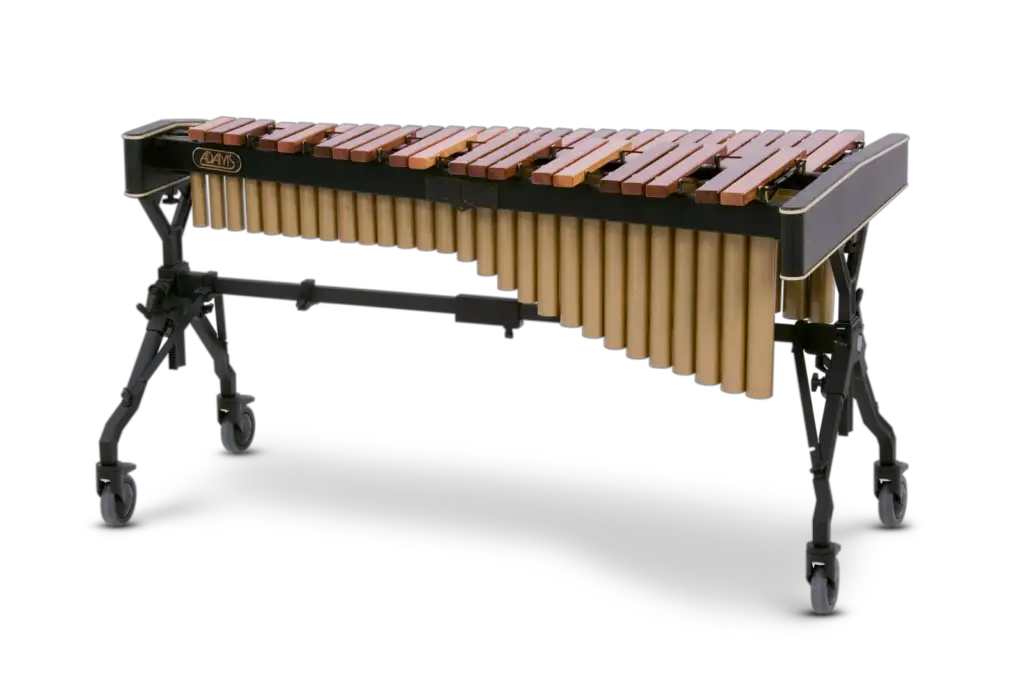The xylophone is one of the oldest melodic instruments in the mallet percussion family.
It differs from the drums, shakers, tambourines, and a long list of effect-creating tools that percussionists use to color orchestra and band music. The xylophones’ sound is sharp, hard-hitting, and distinctive and there is a science and design behind that sound and a technique to make it sing.
The xylophone produces a variety of higher-pitched sounds by striking suspended tone bars with mallets of different hardnesses. The tone bars vibrate and a resonator tube placed underneath some of the tone bars amplifies the vibration-produced sound. These sounds are used in orchestras, bands, and ensembles to add melody, rhythm, and tone color to music.

You have heard a xylophone perhaps without recognizing it.
The sounds can be quick and intense. Maybe you’ve seen someone playing the xylophone, moving their arms rapidly, raising and lowering their hands, and even changing their body language with the mood of the music.
The xylophone is used to create emotion, intensity, and character.
Those who play the xylophone must use different techniques and tools to achieve all of those rhythms, volumes, attacks, and sounds.
How do Xylophones produce sounds?
When a tone bar on a xylophone is struck with a “mallet” it causes the wooden or composite bar to vibrate. This vibration produces a tone that depends on the length and thickness of the bar.
🎵 Higher pitches are produced from shorter tone bars.
🎵 Lower pitches are produced from longer-tone bars.
Some xylophones have tubes placed under some of the bars. The tubes amplify the tone. The tone can also be varied by the type of mallet you use to strike the bars.
Have you ever noticed the interesting arch-shaped cut-out right underneath the bars of your xylophone?
The tone bars on the xylophone produce a sound not only by their difference in length but also because their tone bars are cut out underneath.
The cut-out part of the bar is used to create a thinner layer in the middle of the bar which allows the tone bar material to vibrate more than a solid piece would.
🎵 Note: The cut-out center is also why you want to strike a tone bar in the center to achieve the best quality sound.
The tone bars are varied in length and enhanced by the center cut out underneath and they are suspended.
The suspending of the tone bars helps them vibrate.
Each tone bar has holes drilled through each end. A wrapped cord or string-like material is pulled through each of the bars in the sequence which creates a row of suspended tone bars.
🎵 Note: If you put your hand on a xylophone you can push the row of tone bars down slightly and feel that they are suspended.
How do you make a sound on the Xylophone?
The sounds on a xylophone are made by striking the tone bars with a mallet.
Xylophone mallets can be made of spun yarn, cotton, rubber, wood, plastic, or acrylic. Different attacks and volume result from the type of mallet you use and the way you use it.
If you strike the bars harder, they will be louder. If you use a yarn mallet to strike the xylophone, the sound will be soft and muffled. If you use a hard plastic mallet to strike the xylophone, the sound will be loud and staccato or short and percussive.
The proper way to strike the tone bars is in a “down-up” motion striking it directly in the center of the tone bar. Strike downward and immediately lift the mallet off of the tone bar so that it vibrates or resonates without the mallet sitting on it.
You can use as many mallets as you can hold at one time per hand to achieve a variety of melodic and rhythmic sounds from the xylophone. Using one mallet in each hand is the most common for beginners. Intermediate and advanced xylophone players used multiple mallets in each hand to play chords and more complicated melodic runs and rhythms.
Is the Xylophone pitched or unpitched?
The xylophone is included in the percussion family of instruments because it is struck with another object, a mallet.
It is not considered a drum or idiophone because, unlike a drum, it does not have a drum head or “membrane.”
The xylophone is considered a pitched instrument because it has multiple tone bars which have individual tones or pitches.
The xylophone can be used in a percussive or melodic way depending on the song or the instrument’s particular place in an ensemble of other instruments. The pitches of the xylophone include multiple octaves which is the 12-tone chromatic scale.
The design of the xylophone is like a piano keyboard. The tone bars are arranged in upper and lower rows. The range of the rows is typically 4 octaves or sets of the 12-tone scale, with the sharps and flats (or the “black keys” on a piano) on the upper row and the natural tones (the “white keys” on a piano) on the lower row.
Fun Fact: The word xylophone comes from ancient Greek. XYLON- (meaning wood) and PHONE- (meaning sound). This name has been used since the 19th century!
How many sounds does a Xylophone have?
All of the “mallet” instruments in the percussion family, including the xylophone, are designed like a piano.

The sounds come from the many octaves of tone bars on the instrument.
Xylophones can be as small as 2+½ octaves and as large as 4 octaves. Xylophones that are 3+½ to 4 octaves are called Concert Xylophones. A xylophone can produce between 30-48 different sounds depending on its size.
Xylophone can be heard in a variety of music from classical to rock. Their sounds can create moods and shapes as well as melodies and signatures.
What Does a Xylophone Sound like?
The xylophone has the brightest and most staccato sound of the wooden mallet percussion instruments. It is both melodic and percussive.
It is often used to create fast and intense moods with musical runs and distinct percussive hits and rhythms. The sounds and tones can be described as clear, hard, transparent, wooden, ticking, bright, hollow, rattling, shrill, sharp, piercing, or precise.
Example:
How Does the Xylophone Sound Compare to Other Mallet Instruments?
All mallet instruments have their own distinct sound when compared to each other. A good percussionist will be able to tell which instrument it is just by listening to its sound as well as when each instrument should be used in a piece of music.
Below is a comparison chart of how the instruments sound different from each other.
| Instrument | What it sounds like |
| Xylophone | Bright, crisp, and sharp sound that cuts through an ensemble |
| Bass Xylophone | Produces deep, resonant tones with a rich and full-bodied sound. |
| Marimba | A dark, warm sound that can blend into an ensemble Has a lower register than a Xylophone |
| Vibraphone | Has a pedal that manipulates the sound Pedal up = muted sound Pedal down = Sustained sound that rings out Generally more mellow and damp sounding |
| Glockenspiel | Has a tingly metal sound with notes that ring out unless muted |
🎵 Note: To read all about percussion instruments similar to the Xylophone and to see how they sound check out this article: 7 Instruments Similar to the Xylophone (With Video Samples) – Top Music Tips
Disclaimer: This post may contain affiliate links. We only recommend high-quality products that are used and recommended by real musicians. If you use these links to buy something we earn a small commission.
